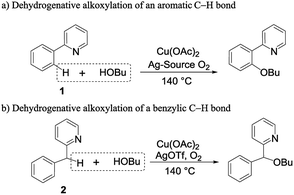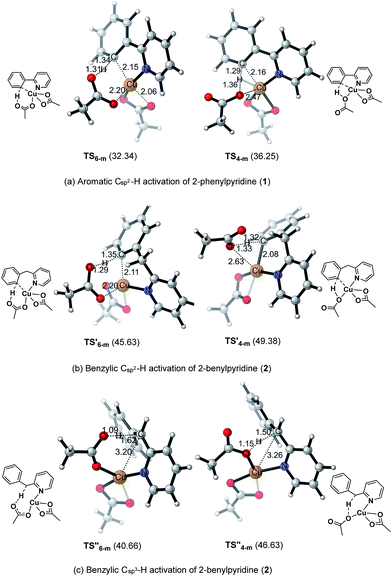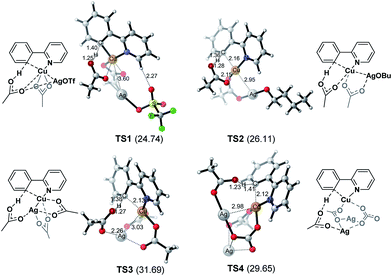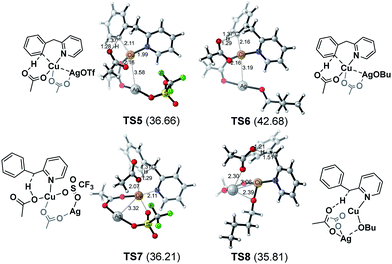Mechanistic insight into Cu/Ag-cocatalyzed C–H activation of arenes with oxygen as the terminal oxidant†
Gui-Yu Ruan‡
,
Zheng-Hang Qi‡,
Ye Zhang,
Wei Liu* and
Yong Wang*
College of Chemistry, Chemical Engineering and Materials Science, Soochow University, Suzhou 215123, P. R. China. E-mail: yowang@suda.edu.cn; weiliu@suda.edu.cn
First published on 29th March 2016
Abstract
The possible transition states of C–H activation on the dehydrogenate coupling of arenes with alcohols employing Ag(I) additives were investigated using B3LYP density functional theory. The AgOTf salt with Cu(OAc)2 was identified as the most active catalyst. The facile occurrence of the studied reactions is supported by the low activation energies of their respective transition states.
Transition-metal-catalyzed C–H bond activation reactions are a significant and important model for C–C and C–heteroatom bond formation.1 Over the past few decades, Ru,2 Rh,3 Pd,4,5 and Ir6 catalysts have been used widely in modern organic synthesis. It can be noted that the C(sp2)–H activation/arylation of arenes and heteroarene has recently been developed.7 In contrast, relatively few developed methods have focused on the regioselective functionalization of alkyl C(sp3)–H activations.8 In 2011, Etienne et al. reported the aromatic vs. benzylic C–H bond activation of alkylaromatics by the steric influence of an ortho methyl group using Nb catalyst.9 Based on the pioneering studies through Cu-catalyzed Ullmann reactions10 or Chan–Evans–Lam reactions,11 Cu catalysts have received growing interest because cost-effective, low-toxic, less exotic, and selective catalysts are essential for future profit-driven synthesis.12 Notably, one of the typical cases in the copper-catalyzed coupling reaction is the Cu(OAc)2-catalyzed C–H activation.13 It was found that copper acetate catalyzes a wide variety of aerobic C–H oxidation reactions and the terminal oxidant helps reform the active catalyst to restart the catalytic cycle.14 In this context, experimental and theoretical investigations are of vital importance.
It is important to recognize that large numbers of aromatic C–N and C–C formations via C–H activations have been achieved using Pd(OAc)2 catalyst besides Cu(OAc)2 as an additive.15 During those reactions, the additives achieve the transition-metal catalyst regeneration toward the later part of the catalytic cycle. Recently, in the dehydrogenative cross-coupling of arenes with alcohols, Gooβen et al. proved experimentally that bimetallic Cu/Ag catalysts are effective (Scheme 1),16 in which silver(I) triflate as an additive was used. While those examples of the use of additives on the efficiency of the transition-metal-catalytic processes are experimentally available in abundance, few theoretical investigations have been reported until now. In 2014, Schaefer III et al. reported a new hetero-bimetallic Pd(OAc)2–Ag species as the most likely active species, in which they found that the additive AgOAc played an important role in the catalyst recycling.17 In 2014, Rh(III)–AgOAc catalyst system was predicted to be favorable in the C–H activation step with DFT calculations by Zhao et al.18 Gooβen et al. investigated the reaction mechanism of decarboxylative cross-couplings of benzoates with aryl halides, where they found that the bidentate ligands are likely to assist in the formation of cooperative copper/palladium bimetallic intermediates during the rate-determining step.19 In addition, Yu, Wu, and Houk et al. theoretically and deeply investigated Pd/Ag cocatalyzed C–H activation with the nitrile-containing template via a concerted-metalation–deprotonation (CMD) mechanism.20 As one part of our ongoing study toward understanding the mechanisms of Cu-catalyzed C–H activation,21 we are interested in examining the role of the additives (AgOTf) and the mechanisms of the regiospecific dehydrogenative cross-coupling of arenes with alcohols by copper–silver catalysts, as shown in Scheme 1, by density functional theory (DFT) calculations using the Gaussian 09 suite of program with the B3LYP/6-311+G(d,p)+Lanl2dz level of theory.
 | ||
| Scheme 1 Copper/silver-catalyzed dehydrogenative alkoxylation of arenes with alcohols.12 | ||
From the high kinetic isotope effect (kH/kD = 3.3),16 the vital C–H activations of arenes are focused on in this communication. The resulting alkoxyarene is achieved by ortho-C–H activation due to the proximity between the metal and the aryl C–H bond. Importantly, a ligand-assisted CMD mechanism was found to be a favorable process in the step of C–H activation.22 Thus, the CMD process has been examined carefully. HOBu was also considered in the model reaction. Correspondingly, some Cu(II) complexes may exist in equilibrium through ligand exchange and they may activate C–H bonds of arenes in different ways. In addition, the effects of O2 was ignored, because the oxygen appeared only to help regenerate the Cu-catalyst back to its native oxidation state during the reaction cycle used under the optimized reaction conditions.14,16 Our discussion is presented in terms of the Gibbs free energies using density functional theory (DFT); the full details are shown in ESI.†
First, a conventional pathway wherein 2-phenylpyridine (1) and 2-benzylpyridine (2) were reacted with 1-butanol under a single Cu(OAc)2 catalyst, respectively. The C–H activation by Cu(OAc)2 is considered the first step to generate the preceding intermediates. As shown in Fig. 1, the acetate-assisted CMD aromatic C–H activation occurs through six-membered (TS6-m) and four-membered (TS4-m) transition state for aromatic C–H activation of 1 by overcoming the activation barrier of 32.34 and 36.25 kcal mol−1, respectively. To the best of our knowledge, the six-membered transition state, TS6-m is more favorable than the four-membered transition state TS4-m. In TS6-m, the CH3COO− ligand promoted ortho-C–H activation of 2-phenylpyridine. The Cu–phenyl bond length was shortened, whereas the C–H bond was elongated to 1.34 Å and O–H bond was close to 1.31 Å, which showed the migration of the N-phenyl fragment to the Cu atom concomitantly with proton transfer from the ortho-C–H of 2-phenylpyridine to the CH3COO− anion. An important consideration for predicting reactivity in the system is that the activation barriers of aromatic C–H activation transition states (TS′6-m and TS′4-m) of 2-benzylpyridine 2 are about 13 kcal mol−1 higher than those of the aromatic C–H activations of 1 (Fig. 1), due to the destabilization of TS′6-m from a 1,3-diaxial interaction. Similar to the aromatic C–H activation of 2, the six-membered transition state TS′′6-m of benzylic C–H activation of 2 is 40.66 kcal mol−1, which is significantly lower than that (46.63 kcal mol−1) of four-membered transition state, TS′′4-m. Notable is the barrier difference between TS′6-m (45.63 kcal mol−1) and TS′′6-m (40.66 kcal mol−1), indicating that benzylic C–H activation is more favorable than the aromatic C–H activation of 2.
Fig. 2 depicts four Ag(I) additives promoted aromatic C–H activation transition states. Compared to aromatic C–H activation (32.34 kcal mol−1) solely using Cu(OAc)2 as the catalyst, the inclusion of silver additives in the transition states was found to be energetically more favored in the aromatic C–H activation by overcoming relatively lower activation barrier of 24.74 (AgOTf, TS1), 26.11 (AgOBu, TS2), 31.69 (AgOAc, TS3), and 29.65 (Ag2CO3, TS4) kcal mol−1. Interestingly, there is a negligible difference (1.37 kcal mol−1) of the activation barriers between AgOTf and AgOBu additives as well as experimental observations,16 in which AgOBu may exist in equilibrium through ligand exchange by the explicit inclusion of AgOTf and HOBu in the solution. The improved favorability of TS1 with AgOTf is 7.6 kcal mol−1 lower than that of TS6-m (32.34 kcal mol−1). The Cu⋯Ag distances are shortened to about 2.95–3.60 Å, indicating stronger d9–d10 hetero-bimetallic electronic interactions. Direct metal–metal interactions have already been reported in experimental and theoretical studies.17,23 The inclusion of Ag(I) additives in the transition states was found to help in C–H activation. In TS1, the CH3COO− ligand migrates to the Ag atom concomitantly with proton transfer from aromatic ortho-C–H of 2-phenylpyridine to the CH3COO− anion. In contrast, the activation energy with the AgOAc or Ag2CO3 additive is higher than that of the AgOTf additive. This is in qualitative agreement with the experimental observations of different reactivity obtained from arenes with alcohols reactions.16 Unfortunately, no transition state by the Ag2O additive was located.
A comparison worth considering is that the activation barriers of the aromatic and benzylic C–H activation transition states of 2-benzylpyridine 2 with AgOTf and AgOBu additives are about 10 kcal mol−1 higher than those aromatic C–H activations of 1 (Fig. 2 and 3). This means that the reactivity of 2-phenylpyridine 1 is larger than that of 2-benzylpyridine 2, which is in good agreement with the experimental results. As shown in Fig. 3, only AgOTf and AgOBu were considered in aromatic and benzylic C–H activation as the more favorable additives. As expected, both modes of benzylic C–H activation (TS7 and TS8) are lower in free energy than the corresponding aromatic C–H activation (TS5 and TS6). After C–H activation, one AcOH molecule is also generated.
In conclusion, the possible transition states of C–H activation of the rate-determining steps on the dehydrogenate coupling of arenes with alcohols were studied through DFT calculations. Among all the transition states of C–H activation investigated, TS1 (under Cu(OAc)2/AgOTf co-catalyst) was found to be kinetically most favorable. That is, the AgOTf additive causes an obvious decrease in the activation barrier. This is consistent with the experimental observation of a higher efficiency of the reaction when Cu(OAc)2 is used in conjunction with AgOTf. The results reported herein are expected to enrich the understanding of C–H activation by a metal (Cu and Ag)-cocatalyzed system.
Acknowledgements
The authors appreciate the financial support from the Starting-up Foundation (Q410900111 and Q410900211) and the Scientific Research Foundation of Soochow University (SDY2012A07), and the Natural Science Foundation of China (21201127). This project was funded by the Priority Academic Program Development of Jiangsu Higher Education Institutions (PAPD).Notes and references
- (a) W. R. Gutekunst and P. S. Baran, Chem. Soc. Rev., 2011, 40, 1976 RSC; (b) L. Ackermann, R. Vicente and A. R. Kapdi, Angew. Chem., Int. Ed., 2009, 48, 9792 CrossRef CAS PubMed; (c) X. Chen, K. M. Engle, D.-H. Wang and J.-Q. Yu, Angew. Chem., Int. Ed., 2009, 48, 5094 CrossRef CAS PubMed; (d) V. Chandrasekhar and B. Murugesapandian, Acc. Chem. Res., 2009, 12, 1047 CrossRef PubMed; (e) G. P. McGlacken and L. M. Bateman, Chem. Soc. Rev., 2009, 38, 2447 RSC; (f) D. Alberico, M. E. Scott and M. Lautens, Chem. Rev., 2007, 107, 174 CrossRef CAS PubMed; (g) L. Ackermann, Chem. Rev., 2011, 50, 1315 CrossRef PubMed; (h) P. B. Arockiam, C. Bruneau and P. H. Dixneuf, Chem. Rev., 2012, 112, 5879 CrossRef CAS PubMed; (i) D. Leow, G. Li, T. S. Mei and J.-Q. Yu, Nature, 2012, 486, 518 CrossRef CAS PubMed.
- (a) L. Ackermann, A. Althammer and R. Born, Angew. Chem., Int. Ed., 2006, 45, 2619 CrossRef CAS PubMed; (b) J. M. Murphy, J. D. Lawrence, K. Kawamura, C. Incarvito and J. F. Hartwig, J. Am. Chem. Soc., 2006, 128, 13684 CrossRef CAS PubMed; (c) Y. Matsuura, M. Tamura, T. Kochi, M. Sato, N. Chatani and F. Kakiuchi, J. Am. Chem. Soc., 2007, 129, 9858 CrossRef CAS PubMed.
- (a) J. C. Lewis, R. G. Bergman and J. A. Ellman, J. Am. Chem. Soc., 2007, 129, 5332 CrossRef CAS PubMed; (b) B. J. Stokes, H. Dong, B. E. Leslie, A. L. Pumphrey and T. G. Driver, J. Am. Chem. Soc., 2007, 129, 7500 CrossRef CAS PubMed; (c) K. W. Fiori and J. Du Bois, J. Am. Chem. Soc., 2007, 129, 562 CrossRef CAS PubMed; (d) R. P. Reddy and H. M. L. Davies, Org. Lett., 2006, 8, 5013 CrossRef CAS PubMed; (e) J. C. Lewis, A. M. Berman, R. G. Bergman and J. A. Ellman, J. Am. Chem. Soc., 2008, 130, 2493 CrossRef CAS PubMed.
- (a) J. H. Delcamp and M. C. White, J. Am. Chem. Soc., 2006, 128, 15076 CrossRef CAS PubMed; (b) S. Yang, B. Li, X. Wan and Z. Shi, J. Am. Chem. Soc., 2007, 129, 6066 CrossRef CAS PubMed; (c) K. L. Hull and M. S. Sanford, J. Am. Chem. Soc., 2007, 129, 11904 CrossRef CAS PubMed; (d) D. R. Stuart, E. Villemure and K. Fagnou, J. Am. Chem. Soc., 2007, 129, 12072 CrossRef CAS PubMed; (e) K. Inamoto, T. Saito, M. Katsuno, T. Sakamoto and K. Hiroya, Org. Lett., 2007, 9, 2931 CrossRef CAS PubMed; (f) S. Potavathri, K. C. Pereira, S. I. Gorelsky, A. Pike, A. P. LeBris and B. DeBoef, J. Am. Chem. Soc., 2010, 132, 14676 CrossRef CAS PubMed; (g) B. Xiao, Z.-J. Liu, L. Liu and Y. Fu, J. Am. Chem. Soc., 2013, 135, 616 CrossRef CAS PubMed.
- M. Hoyos, R. S. Sprick, C. Wang, M. L. Turner and O. Navarro, J. Polym. Sci., Part A: Polym. Chem., 2012, 50, 4155 CrossRef CAS.
- (a) A. Parija and R. B. Sunoj, Org. Lett., 2013, 15, 4066 CrossRef CAS PubMed; (b) R. Yamaguchi, S. Kawagoe, C. Asai and K.-i. Fujita, Org. Lett., 2007, 10, 181 CrossRef PubMed; (c) G. Cami-Kobeci and J. M. J. Williams, Chem. Commun., 2004, 9, 1072 RSC.
- (a) X. Chen, J.-J. Li, X.-S. Hao, C. E. Goodhue and J.-Q. Yu, J. Am. Chem. Soc., 2006, 128, 78 CrossRef CAS PubMed; (b) F. Kakiuchi and N. Chatani, Adv. Synth. Catal., 2003, 345, 1077 CrossRef CAS; (c) G. P. McGlacken and L. M. Bateman, Chem. Soc. Rev., 2009, 38, 2447 RSC.
- (a) X. Chen, C. E. Goodhue and J.-Q. Yu, J. Am. Chem. Soc., 2006, 128, 12634 CrossRef CAS PubMed; (b) D. Shabashov and O. Daugulis, Org. Lett., 2005, 7, 3657 CrossRef CAS PubMed; (c) S. Rousseaux, S. I. Gorelsky, B. K. W. Chung and K. Fagnou, J. Am. Chem. Soc., 2010, 132, 10692 CrossRef CAS PubMed; (d) S. Rousseaux, S. I. Gorelsky, B. K. W. Chung and K. Fagnou, J. Am. Chem. Soc., 2010, 132, 10692 CrossRef CAS PubMed; (e) M. Ghobrial, K. Harhammer, M. D. Mihovilovic and M. Schnurch, Chem. Commun., 2010, 46, 8836 RSC.
- C. d. Boulho, L. Vendier, M. Etienne, A. Locati, F. Maseras and J. E. McGrady, Organometallics, 2011, 30, 3999 CrossRef CAS.
- (a) S. V. Ley and A. W. Thomas, Angew. Chem., Int. Ed., 2003, 42, 5400 CrossRef CAS PubMed; (b) F. Monnier and M. Taillefer, Angew. Chem., Int. Ed., 2009, 48, 6954 CrossRef CAS PubMed.
- G. C. Nandi, S. R. Kota, T. Govender, H. G. Kruger and P. I. Arvidsson, Tetrahedron, 2014, 70, 5428 CrossRef CAS.
- (a) O. Daugulis, H. Q. Do and D. Shabashov, Acc. Chem. Res., 2009, 42, 1074 CrossRef CAS PubMed; (b) C. Zhang, H. H. Huang, H. Niu and J. Y. Dong, Appl. Organomet. Chem., 2010, 24, 641 CrossRef CAS; (c) A. E. Wendlandt, A. M. Suess and S. S. Stahl, Angew. Chem., Int. Ed., 2011, 50, 11062 CrossRef CAS PubMed.
- (a) F. Shi, M. K. Tse, X. Cui, D. Gördes, D. Michalik, K. Thurow, Y. Deng and M. Beller, Angew. Chem., Int. Ed., 2009, 48, 5912 CrossRef CAS PubMed; (b) A. Martínez-Asencio, D. J. Ramón and M. Yus, Tetrahedron Lett., 2010, 51, 325 CrossRef; (c) G. Brasche and S. L. Buchwald, Angew. Chem., Int. Ed., 2008, 47, 1932 CrossRef CAS PubMed; (d) A. John and K. M. Nicholas, J. Org. Chem., 2011, 76, 4158 CrossRef CAS PubMed.
- (a) S. Tang, T. Gong and Y. Fu, Sci. China: Chem., 2013, 56, 619 CrossRef CAS; (b) A. M. Suess, M. Z. Ertem, C. J. Cramer and S. S. Stahl, J. Am. Chem. Soc., 2013, 135, 9797 CrossRef CAS PubMed; (c) K.-S. Masters, T. R. M. Rauws, A. K. Yadav, W. A. Herrebout, B. Van der Veken and B. U. W. Maes, Chem.–Eur. J., 2011, 17, 6315 CrossRef CAS PubMed; (d) H.-F. He, Z.-J. Wang and W. Bao, Adv. Synth. Catal., 2010, 352, 2905 CrossRef CAS.
- (a) L. Jiang and S. L. Buchwald, in Metal-Catalyzed Cross-Coupling Reactions, ed. F. Diederich and P. J. Stang, Wiley-VCH, Weinheim, Germany, 2nd edn, 2004, p. 699 Search PubMed; (b) I. P. Beletskaya and A. V. Cheprakov, Coord. Chem. Rev., 2004, 248, 2337 CrossRef CAS; (c) S. V. Ley and A. W. Thomas, Angew. Chem., Int. Ed., 2003, 42, 5400 CrossRef CAS PubMed; (d) J. F. Hartwig, in Handbook of Organopalladium Chemistry for Organic Synthesis, ed. E. Negishi, Wiley-Interscience, New York, 2002, p. 1051 Search PubMed; (e) W. C. P. Tsang, N. Zheng and S. L. Buchwald, J. Am. Chem. Soc., 2005, 127, 14560 CrossRef CAS PubMed.
- S. Bhadra, C. Matheis, D. Katayev and L. J. Gooβen, Angew. Chem., Int. Ed., 2013, 52, 9279 CrossRef CAS PubMed.
- M. Anand, R. B. Sunoj and H. F. Schaefer III, J. Am. Chem. Soc., 2014, 136, 5535 CrossRef CAS PubMed.
- L. Liu, Y. Wu, T. Wang, X. Gao, J. Zhu and Y. Zhao, J. Org. Chem., 2014, 79, 5074 CrossRef CAS PubMed.
- A. Fromm, C. van Wüllen, D. Hackenberger and L. J. Gooβen, J. Am. Chem. Soc., 2014, 136, 10007 CrossRef CAS PubMed.
- Y.-F. Yang, G.-J. Cheng, P. Liu, D. Leow, T.-Y. Sun, P. Chen, X. Zhang, J.-Q. Yu, Y.-D. Wu and K. N. Houk, J. Am. Chem. Soc., 2014, 136, 344 CrossRef CAS PubMed.
- G.-Y. Ruan, Y. Zhang, Z.-H. Qi, D.-X. Ai, W. Liu and Y. Wang, Comput. Theor. Chem., 2015, 1054, 16 CrossRef CAS.
- (a) D. L. Davies, S. M. A. Donald, O. Al-Duaij, S. A. Macgregor and M. Pölleth, J. Am. Chem. Soc., 2006, 128, 4210 CrossRef CAS PubMed; (b) Y.-F. Yang, G.-J. Cheng, P. Liu, D. Leow, T.-Y. Sun, P. Chen, X. Zhang, J.-Q. Yu, Y.-D. Wu and K. N. Houk, J. Am. Chem. Soc., 2013, 136, 344 CrossRef PubMed; (c) B. Lian, L. Zhang, G. A. Chass and D.-C. Fang, J. Org. Chem., 2013, 78, 8376 CrossRef CAS PubMed.
- (a) G. L. Petretto, J. P. Rourke, L. Maidich, S. Stoccoro, M. A. Cinellu, G. Minghetti, G. J. Clarkson and A. Zucca, Organometallics, 2012, 31, 2971 CrossRef CAS; (b) R. Giri, Y. Lan, P. Liu, K. N. Houk and J.-Q. Yu, J. Am. Chem. Soc., 2012, 134, 14118 CrossRef CAS PubMed; (c) R. Giri, X. Chen and J.-Q. Yu, Angew. Chem., Int. Ed., 2005, 44, 2112 CrossRef CAS PubMed; (d) R. D. Adams, B. Captain and L. Zhu, J. Am. Chem. Soc., 2006, 128, 13672 CrossRef CAS PubMed.
Footnotes |
| † Electronic supplementary information (ESI) available: Cartesian coordinates for all optimized reactants, intermediates, transition states, and products reported in this work. See DOI: 10.1039/c6ra04411e |
| ‡ These authors contributed equally to this work. |
| This journal is © The Royal Society of Chemistry 2016 |



